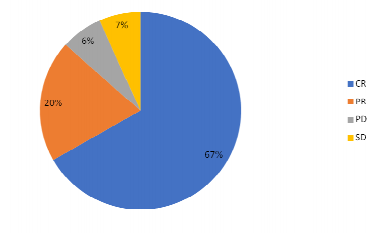Hyperfractionated radiotherapy with concurrent chemotherapy in locally advanced head and neck cancer – An observational study
Abstract
Introduction: Radiotherapy plays an important role in the multidisciplinary treatment of locally advanced head and neck cancer, but the rates of locoregional recurrence are high and survival is poor. Thus, there was an emergence of altered fractionation. The purpose of this study is to see the treatment overall response of Hyperfractionated Radiotherapy with concurrent chemotherapy in locally advanced Head and Neck Cancer patients.
Material & Methods: This was an observational study conducted in the Department of Radiation Oncology, Pravara Rural Hospital, Loni between September 2018 to September 2019. Fifteen histopathologies proved patients with locally advanced head and neck cancer received Hyperfractionated radiotherapy (HFRT) with concurrent chemotherapy. Patients received 6760cGy to 7260cGy in 66-70 fractions, 110cGy per fraction, 2 fractions per day with 6 hours gap over 7-8 weeks and weekly injection cisplatin 30 mg/m2.
Results: At the endpoint of 6 months which was the minimum follow up for all patients the overall response and complete response was 86.66% and 66.66% respectively. The complete response rate was 80% and 60% in Stage III and Stage IV patients respectively.
Conclusion: Hyperfractionated Radiotherapy with concurrent chemotherapy gives good local control and improved overall response in locally advanced head and neck squamous cancer. However larger studies should be done to confirm the results.
Downloads
References
Jemal A, Bray F, Center M, Ferlay J, Ward E, Forman D. Global cancer statistics. CA: A Cancer Journal for Clinicians. 2011;61(2):69-90.
Jemal A, Siegel R, Ward E, Murray T, Xu J, Thun M. Cancer Statistics, 2007. CA: A Cancer Journal for Clinicians. 2007;57(1):43-66.
Boyle P. Eurocan Plus Report: Feasibility Study for Coordination of National Cancer Research Activities. ecancermedicalscience. 2008;.
D′Cruz A, Shah S, Sharma S. Head and neck oncology: The Indian scenario. 2019.
Factors Which Can Increase the Risk of Oral Cancer - Asian Health Blog [Internet].Aimsindia.com. 2019 [cited 13 November 2019]. Available from: https://www.aimsindia.com/blog/factorswhich-can-increase-the-risk-of-oral-cancer/
Gupta B, Johnson N, Kumar N. Global Epidemiology of Head and Neck Cancers: A Continuing Challenge. Oncology. 2016;91(1):13-23.
Applebaum K, Furniss C, Zeka A, Posner M, Smith J, Bryan J et al. Lack of Association of Alcohol and Tobacco with HPV16-Associated Head and Neck Cancer. JNCI: Journal of the National Cancer Institute. 2007;99(23):1801-1810.
Petti S. Lifestyle risk factors for oral cancer. Oral Oncology. 2009;45(4-5):340- 350.
Pelucchi C, Gallus S, Garavello W, Bosetti C, La Vecchia C. Alcohol and tobacco use, and cancer risk for upper aerodigestive tract and liver. European Journal of Cancer Prevention. 2008;17(4):340-344.
Lambert R, Sauvaget C, de Camargo Cancela M, Sankaranarayanan R. Epidemiology of cancer from the oral cavity and oropharynx. European Journal of Gastroenterology & Hepatology. 2011;23(8):633-641.
Horiot J, Bontemps P, van der Bogaert W, Le Fur R, van der Weijngaert D, Bolla M et al. Accelerated fractionation compared ta conventional fractionation improves locoregional control in the radiotherapy of advanced head and neck cancers: results of EORTC 22851 randomized trial. Cancer/Radiothérapie. 1998;2(1):83-84.
Horiot J, Le Fur R, N'Guyen T, Chenal C, Schraub S, Alfonsi S et al. Hyperfractionation versus conventional fractionation in oropharyngeal carcinoma: final analysis of a randomized trial of the EORTC cooperative group of radiotherapy. Radiotherapy and Oncology. 1992;25(4):231-241.
Overgaard J, Hansen H, Specht L, Overgaard M, Grau C, Andersen E, et al. Five compared with six fractions per week of conventional radiotherapy of quamouscell carcinoma of head and neck: DAHANCA 6&7 randomized controlled trial. The Lancet. 2003;362(9388):933-940.
Bourhis J, Overgaard J, Audry H, Ang K, Saunders M, Bernier J et al. Hyperfractionated or accelerated radiotherapy in head and neck cancer: a meta-analysis. The Lancet. 2006;368(9538):843-854.
Pignon J, Maître A, Maillard E, Bourhis J. Meta-analysis of chemotherapy in head and neck cancer (MACH-NC): An update on 93 randomized trials and 17,346 patients. Radiotherapy and Oncology. 2009;92(1):4- 14.
Colledge J. Response Evaluation Criteria In Solid Tumours - RECIST 1.1 [Internet]. Radiologytutor.com. 2019 [cited 13 November 2019]. Available from: http://www.radiologytutor.com/index.php/cases/oncol/139-recist
Krishnatreya M, Das R, Kataki A, Sharma J, Baishya N, Kalita M. A study of head and neck cancer patients with special reference to tobacco use and educational level. Clinical Cancer Investigation Journal. 2017;6(1):21.
Tallari R, Singh O, Yogi V, Yadav S. Five versus ten fractions per week radiotherapy in locally advanced head and neck cancer. Journal of Cancer Research and Therapeutics. 2017;13(2):224.
Al-Saleh K, et al. Hyperfractionated radiation therapy and concurrent chemotherapy for advanced head and neck cancer. Gulf J Oncology.2011:
Adelstein D. Maximizing Local Control and Organ Preservation in Stage IV Squamous Cell Head and Neck Cancer With Hyperfractionated Radiation and Concurrent Chemotherapy. Journal of Clinical Oncology. 2002;20(5):1405-1410.
Shukovsky L, Fletcher G, Montague E, Withers H. Experience with twice-a-day fractionation in clinical radiotherapy. American Journal of Roentgenology. 1976;126(1):155-162.
Medini E, Rao Y, Kim T, Jones T, Levitt S. Radiation therapy for advanced head and neck squamous cell carcinoma using twicea-day fractionation. Radiology. 1980;134(2):531-532.
Jampolis S, Pipard G, Horiot J, Bolla M, Le Dorze C. Preliminary results using twice-aday fractionation in the radiotherapeutic management of advanced cancers of the head and neck. American Journal of Roentgenology. 1977;129(6):1091-1093.
Fu K, Pajak T, Trotti A, Jones C, Spencer S, Phillips T et al. A radiation therapy oncology group (RTOG) phase III randomized study to compare hyperfractionation and two variants of accelerated fractionation to standard fractionation radiotherapy for head and neck squamous cell carcinomas: first report of RTOG 9003. International Journal of Radiation Oncology*Biology*Physics. 2000;48(1):7-16.
Bourhis J, Overgaard J, Audry H, Ang K, Saunders M, Bernier J et al. Hyperfractionated or accelerated radiotherapy in head and neck cancer: a meta-analysis. 2019.



























